Straw Return with Reduced Nitrogen Fertilizer Maintained Maize High Yield in Northeast China
Abstract
1. Introduction
2. Materials and Methods
2.1. Experimental Site and Design
2.2. Field Management
2.3. Sampling and Data Collection
2.3.1. Leaf Area Index
2.3.2. Leaf Photosynthesis
2.3.3. Plant Dry Matter
2.3.4. Plant Nutrient Analysis
2.3.5. Grain Yield and Yield Components
2.4. Statistical Analysis
3. Results
3.1. Grain Yield and Yield Components
3.2. Plant Dry Matter
3.3. Leaf Area Index (LAI)
3.4. Leaf Photosynthesis
3.5. Post-Flowering Dynamics of Carbon, Nitrogen, Phosphorus, and Potassium in Leaf, Stem, and Grain
3.6. Correlation between Post-Flowering Dynamics of Carbon, Nitrogen, Phosphorus, and Potassium and Grain Yield
4. Discussion
4.1. Straw Return and Grain Yield
4.2. Relationships between Leaf Area Dynamics and Plant Productivity, Plant Nutrient Dynamics, and Straw Return
4.3. Long-Term Application of PK Fertilizers and No Fertilizer
4.4. Relationship between Grain Yield and Plant Nutrient Dynamics
5. Conclusions
Author Contributions
Funding
Acknowledgments
Conflicts of Interest
References
- Fang, H.; Sun, L.; Qi, D.; Cai, Q. Using 137Cs technique to quantify soil erosion and deposition rates in an agricultural catchment in the black soil region, Northeast China. Geomorphology 2012, 169, 142–150. [Google Scholar] [CrossRef]
- Xu, X.; Xu, Y.; Chen, S.C.; Xu, S.; Zhang, H. Soil loss and conservation in the black soil region of Northeast China: A retrospective study. Environ. Sci. Policy 2010, 13, 793–800. [Google Scholar] [CrossRef]
- Han, X.; Li, H.; Horwath, W.R. Temporal variations in soil CO2 efflux under different land use types in the black soil zone of Northeast China. Pedosphere 2013, 23, 636–650. [Google Scholar] [CrossRef]
- Fan, H.; Cai, Q.; Cui, M. Soil erosion developed with the vertical belts in the gentle hilly black soil regions in Northeast China. T. CSAE 2005, 21, 8–11. [Google Scholar]
- Zhang, Y.; Wu, Y.; Liu, B.; Zheng, Q.; Yin, J. Characteristics and factors controlling the development of ephemeral gullies in cultivated catchments of black soil region, Northeast China. Soil Till. Res. 2007, 96, 28–41. [Google Scholar] [CrossRef]
- Subbian, P.; Lal, R.; Subramanian, K.S. Cropping systems effects on soil quality in semi-arid tropics. J. Sustain. Agric. 2000, 16, 7–38. [Google Scholar] [CrossRef]
- Webb, J.; Loveland, P.J.; Chambers, B.J.; Mitchell, R.; Garwood, T. The impact of modern farming practices on soil fertility and quality in England and Wales. J. Agric. Sci. 2001, 137, 127–138. [Google Scholar] [CrossRef]
- Khush, G.S. Green revolution: The way forward. Nat. Rev. Genet. 2001, 2, 815. [Google Scholar] [CrossRef]
- Belay, A.; Claassens, A.; Wehner, F.C. Effect of direct nitrogen and potassium and residual phosphorus fertilizers on soil chemical properties, microbial components and maize yield under long-term crop rotation. Biol. Fert. Soils 2002, 35, 420–427. [Google Scholar]
- Guo, J.; Liu, X.; Zhang, Y.; Shen, J.; Han, W.; Hang, W.Z.; Christie, P.; Goulding, K.W.T.; Vitousek, P.M.; Zhang, F. Significant acidification in major Chinese croplands. Science 2010, 327, 1008–1010. [Google Scholar] [CrossRef] [PubMed]
- Yang, Z.; Zhao, N.; Huang, F.; Lv, Y. Long-term effects of different organic and inorganic fertilizer treatments on soil organic carbon sequestration and crop yields on the North China Plain. Soil Till. Res. 2015, 146, 47–52. [Google Scholar] [CrossRef]
- Gong, W.; Yan, X.; Wang, J.; Hu, T.; Gong, Y. Long-term manure and fertilizer effects on soil organic matter fractions and microbes under a wheat–maize cropping system in northern China. Geoderma 2009, 149, 318–324. [Google Scholar] [CrossRef]
- Yang, S.; Li, F.; Malhi, S.S.; Wang, P.; Suo, D.; Wang, J. Long-term fertilization effects on crop yield and nitrate nitrogen accumulation in soil in Northwestern China. Agron. J. 2004, 96, 1039–1049. [Google Scholar] [CrossRef]
- Lemenih, M.; Karltun, E.; Olsson, M. Assessing soil chemical and physical property responses to deforestation and subsequent cultivation in smallholders farming system in Ethiopia. Agric. Ecosyst. Environ. 2005, 105, 373–386. [Google Scholar] [CrossRef]
- Cakmak, D.; Saljnikov, E.; Mrvic, V.; Jakovljevic, M.; Marjanovic, Z.; Sikiric, B.; Maksimovic, S. Soil properties and trace elements contents following 40 years of phosphate fertilization. J. Environ. Qual. 2010, 39, 541–547. [Google Scholar] [CrossRef]
- Zhang, H.; Yang, X.; He, X.; Xu, M.; Huang, S.; Liu, H.; Wang, B. Effect of long-term potassium fertilization on crop yield and potassium efficiency and balance under wheat-maize rotation in China. Pedosphere 2011, 21, 154–163. [Google Scholar] [CrossRef]
- Singh, H.; Verma, A.; Ansari, M.W.; Shukla, A. Physiological response of rice (Oryza sativa L.) genotypes to elevated nitrogen applied under field conditions. Plant Signal. Behav. 2014, 9, e29015. [Google Scholar] [CrossRef]
- Ju, X.; Kou, C.; Christie, P.; Dou, Z.; Zhang, F. Changes in the soil environment from excessive application of fertilizers and manures to two contrasting intensive cropping systems on the North China Plain. Environ. Pollut. 2007, 145, 497–506. [Google Scholar] [CrossRef]
- Hao, X.; Liu, S.; Wu, J.; Hu, R.; Tong, C.; Su, Y. Effect of long-term application of inorganic fertilizer and organic amendments on soil organic matter and microbial biomass in three subtropical paddy soils. Nutr. Cycl. Agroecosys. 2008, 81, 17–24. [Google Scholar] [CrossRef]
- Bedada, W.; Lemenih, M.; Karltun, E. Soil nutrient build-up, input interaction effects and plot level N and P balances under long-term addition of compost and NP fertilizer. Agric. Ecosyst. Environ. 2016, 218, 220–231. [Google Scholar] [CrossRef]
- Berzsenyi, Z.; Győrffy, B.; Lap, D. Effect of crop rotation and fertilisation on maize and wheat yields and yield stability in a long-term experiment. Eur. J. Agron. 2000, 13, 225–244. [Google Scholar] [CrossRef]
- Li, S.; Li, Y.; Li, X.; Tian, X.; Zhao, A.; Wang, S.; Wang, S.; Shi, J. Effect of straw management on carbon sequestration and grain production in a maize–wheat cropping system in Anthrosol of the Guanzhong Plain. Soil Till. Res. 2016, 157, 43–51. [Google Scholar] [CrossRef]
- Mehmood, K.; Chang, S.; Yu, S.; Wang, L.; Li, P.; Li, Z.; Liu, W.; Rosenfeld, D.; Seinfeld, J.H. Spatial and temporal distributions of air pollutant emissions from open crop straw and biomass burnings in China from 2002 to 2016. Environ. Chem. Lett. 2018, 16, 301–309. [Google Scholar] [CrossRef]
- Zhao, J.; Ni, T.; Li, J.; Lu, Q.; Fang, Z.; Huang, Q.; Zhang, R.; Li, R.; Shen, B.; Shen, Q. Effects of organic–inorganic compound fertilizer with reduced chemical fertilizer application on crop yields, soil biological activity and bacterial community structure in a rice–wheat cropping system. Appl. Soil Ecol. 2016, 99, 1–12. [Google Scholar] [CrossRef]
- Wang, Y.; Zhu, Y.; Zhang, S.; Wang, Y. What could promote farmers to replace chemical fertilizers with organic fertilizers? J. Clean. Prod. 2018, 199, 882–890. [Google Scholar] [CrossRef]
- Lu, R. Analytical Methods of Soil Agro-Chemistry; China Agriculture Science and Technique Press: Beijing, China, 1999; pp. 147–190. [Google Scholar]
- Zarcinas, B.A.; Cartwright, B.; Spouncer, L.R. Nitric acid digestion and multi-element analysis of plant material by inductively coupled plasma spectrometry. Commun. Soil Sci. Plan. 1987, 18, 131–146. [Google Scholar] [CrossRef]
- Efthimiadou, A.; Bilalis, D.; Karkanis, A.; Froud-Williams, B. Combined organic/inorganic fertilization enhance soil quality and increased yield, photosynthesis and sustainability of sweet maize crop. Aust. J. Crop Sci. 2010, 4, 722–729. [Google Scholar]
- Wang, J.; Wang, X.; Xu, M.; Feng, G.; Zhang, W. Crop yield and soil organic matter after long-term straw return to soil in China. Nutr. Cycl. Agroecosys. 2015, 102, 371–381. [Google Scholar] [CrossRef]
- FAO. 2016. Available online: http://www.fao.org/faostat/zh/#compare (accessed on 18 November 2018).
- Tian, G.; Kang, B.T.; Brussaard, L. Biological effects of plant residues with contrasting chemical compositions under humid tropical conditions—Decomposition and nutrient release. Soil Biol. Biochem. 1992, 24, 1051–1060. [Google Scholar] [CrossRef]
- Mubarak, A.R.; Rosenani, A.B.; Anuar, A.R.; Zauyah, S. Decomposition and nutrient release of maize stover and groundnut haulm under tropical field conditions of Malaysia. Commun. Soil Sci. Plan. 2002, 33, 609–622. [Google Scholar] [CrossRef]
- Zhang, W.; Xu, M.; Wang, B.; Wang, X. Soil organic carbon, total nitrogen and grain yields under long-term fertilizations in the upland red soil of southern China. Nutr. Cycl. Agroecosys. 2009, 84, 59–69. [Google Scholar] [CrossRef]
- Kumar, K.; Goh, K.M. Crop residues and management practices: Effects on soil quality, soil nitrogen dynamics, crop yield, and nitrogen recovery. Adv. Agron. 1999, 68, 197–319. [Google Scholar]
- Roper, M.M. Straw decomposition and nitrogenase activity (C2H2 reduction): Effects of soil moisture and temperature. Soil Biol. Biochem. 1985, 17, 65–71. [Google Scholar] [CrossRef]
- Coppens, F.; Garnier, P.; de Gryze, S.; Merckx, R.; Recous, S. Soil moisture, carbon and nitrogen dynamics following incorporation and surface application of labelled crop residues in soil columns. Eur. J. Agron. 2006, 57, 894–905. [Google Scholar] [CrossRef]
- Lou, Y.; Xu, M.; Wang, W.; Sun, X.; Zhao, K. Return rate of straw residue affects soil organic C sequestration by chemical fertilization. Soil Till. Res. 2011, 113, 70–73. [Google Scholar] [CrossRef]
- Zhao, S.; He, P.; Qiu, S.; Jia, L.; Liu, M.; Jin, J.; Johnston, A.M. Long-term effects of potassium fertilization and straw return on soil potassium levels and crop yields in north-central China. Field Crop Res. 2014, 169, 116–122. [Google Scholar] [CrossRef]
- Wang, J.; Wang, D.; Zhang, G.; Wang, Y.; Wang, C.; Teng, Y.; Christie, P. Nitrogen and phosphorus leaching losses from intensively managed paddy fields with straw retention. Agric. Water Manag. 2014, 141, 66–73. [Google Scholar] [CrossRef]
- Hu, H.; Wang, Y.; Chen, Z.; Liu, J.; Xu, Q.; Ma, Y.; Wang, M. Effects of straw return with chemical fertilizer on nitrogen and phosphorus leaching from yellow cinnamon soil. J. Soil Water Conserv. 2015, 29, 101–105. [Google Scholar]
- Haileslassie, A.; Priess, J.A.; Veldkamp, E.; Lesschen, J.P. Nutrient flows and balances at the field and farm scale: Exploring effects of land-use strategies and access to resources. Agric. Syst. 2007, 94, 459–470. [Google Scholar] [CrossRef]
- Shiferaw, B.; Holden, S. Soil erosion and smallholders’ conservation decisions in the highlands of Ethiopia. World Dev. 1999, 27, 739–752. [Google Scholar] [CrossRef]
- Van der Pol, F.; Traore, B. Soil nutrient depletion by agricultural production in Southern Mali. Fertil. Res. 1993, 36, 79–90. [Google Scholar]
- Hao, M.; Fan, J.; Wang, Q.; Dang, T.; Guo, S.; Wang, J. Wheat grain yield and yield stability in a long-term fertilization experiment on the Loess Plateau. Pedosphere 2007, 17, 257–264. [Google Scholar] [CrossRef]
- Ning, P.; Li, S.; Yu, P.; Zhang, Y.; Li, C. Post-silking accumulation and partitioning of dry matter, nitrogen, phosphorus and potassium in maize varieties differing in leaf longevity. Field Crop Res. 2013, 144, 19–27. [Google Scholar] [CrossRef]
- Ciampitti, I.A.; Vyn, T.J. Grain nitrogen source changes over time in maize: A review. Crop Sci. 2013, 53, 366–377. [Google Scholar] [CrossRef]
- Rychter, A.M.; Rao, I.M. Role of phosphorus in photosynthetic carbon metabolism. Handbook Photosynth. 2005, 2, 123–148. [Google Scholar]
- Wang, M.; Zheng, Q.; Shen, Q.; Guo, S. The critical role of potassium in plant stress response. Int. J. Mol. Sci. 2013, 14, 7370–7390. [Google Scholar] [CrossRef]
- Tighe-Neira, R.; Alberdi, M.; Arce-Johnson, P.; Romero, J.; Reyes-Díaz, M.; Rengel, Z.; Inostroza-blancheteau, C. Role of potassium in governing photosynthetic processes and plant yield. In Plant Nutrients and Abiotic Stress Tolerance; Hasanuzzaman, M., Fujita, M., Oku, H., Nahar, K., Hawrylak-Nowak, B., Eds.; Springer: Singapore, 2018; pp. 191–203. [Google Scholar]
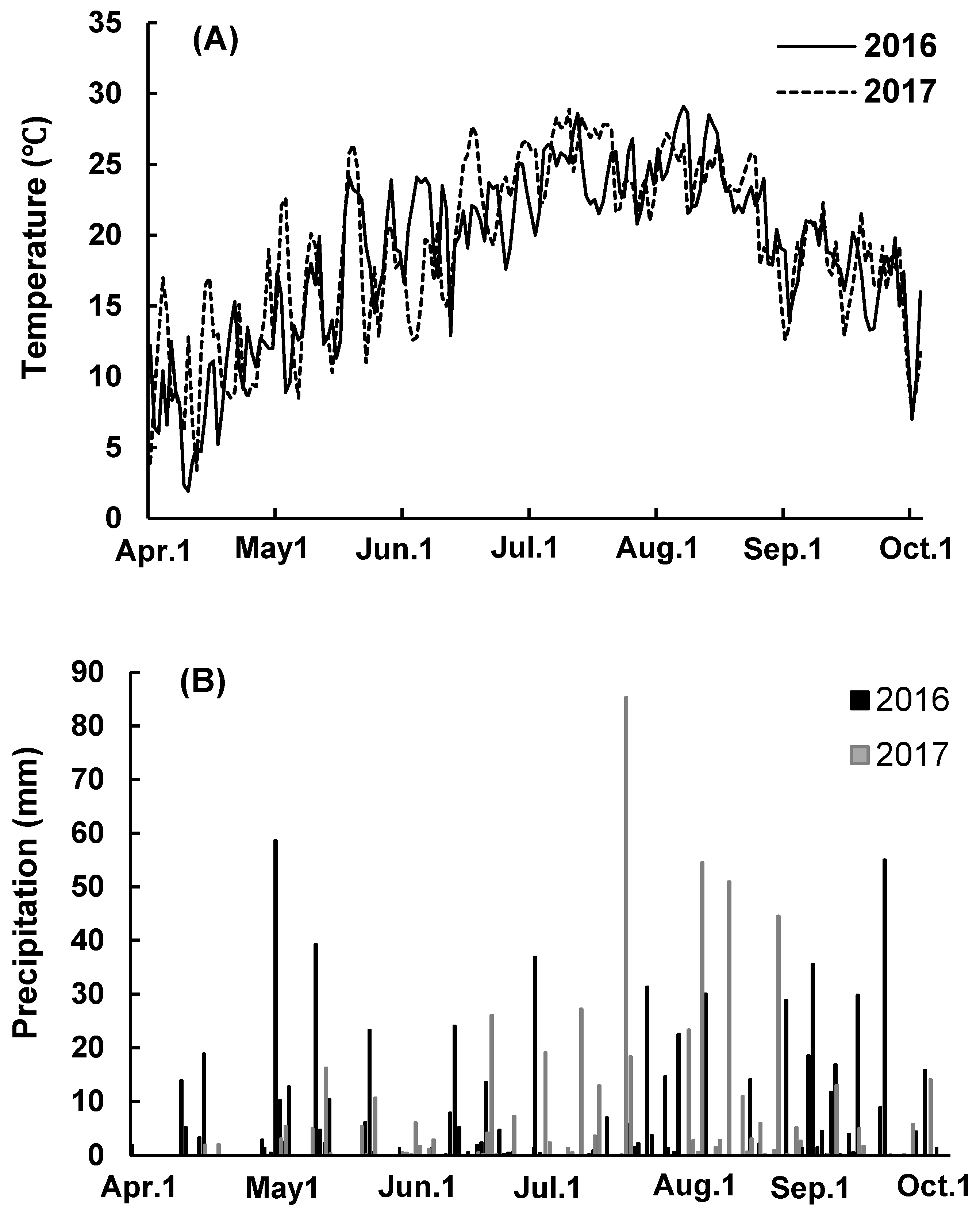
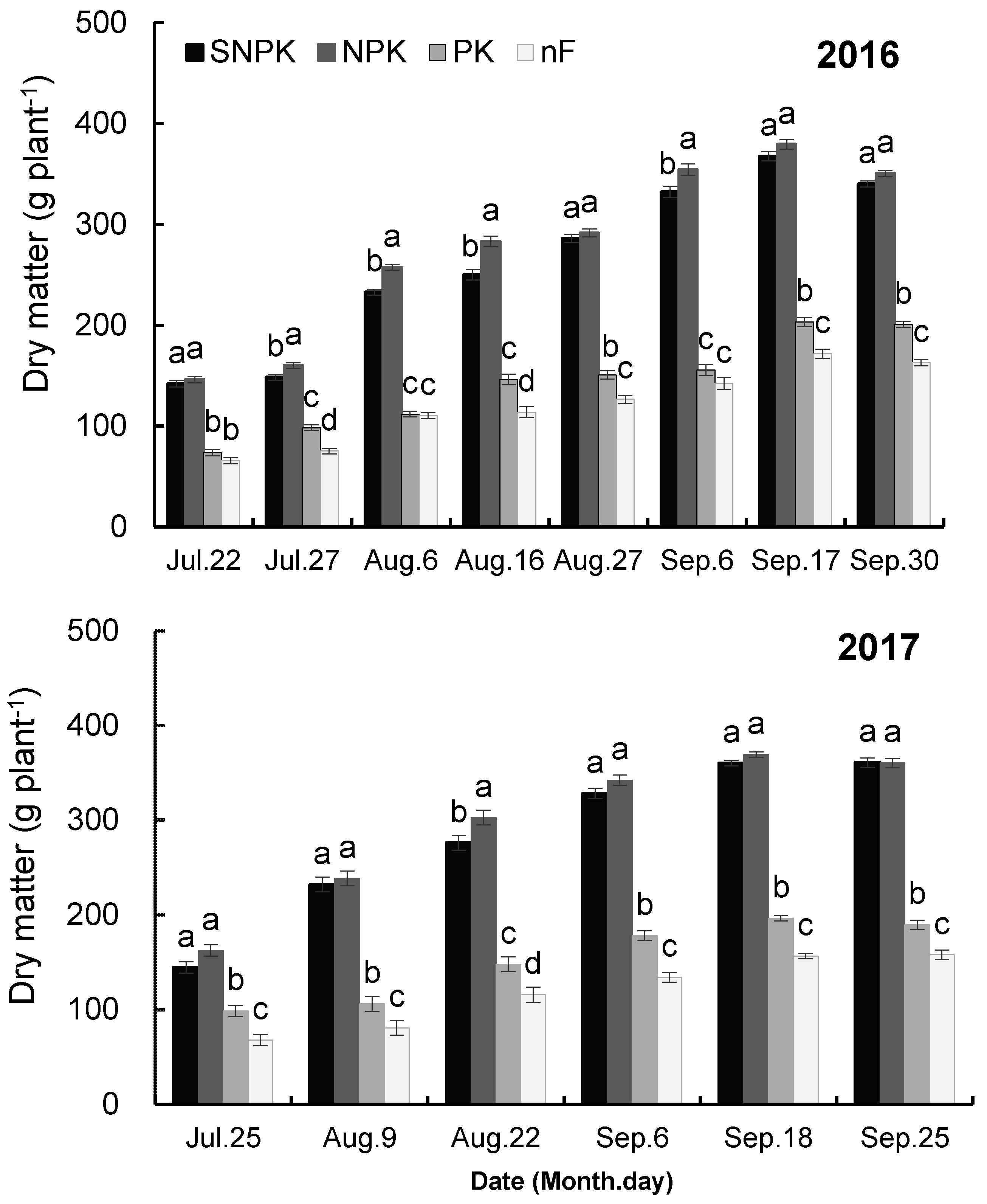
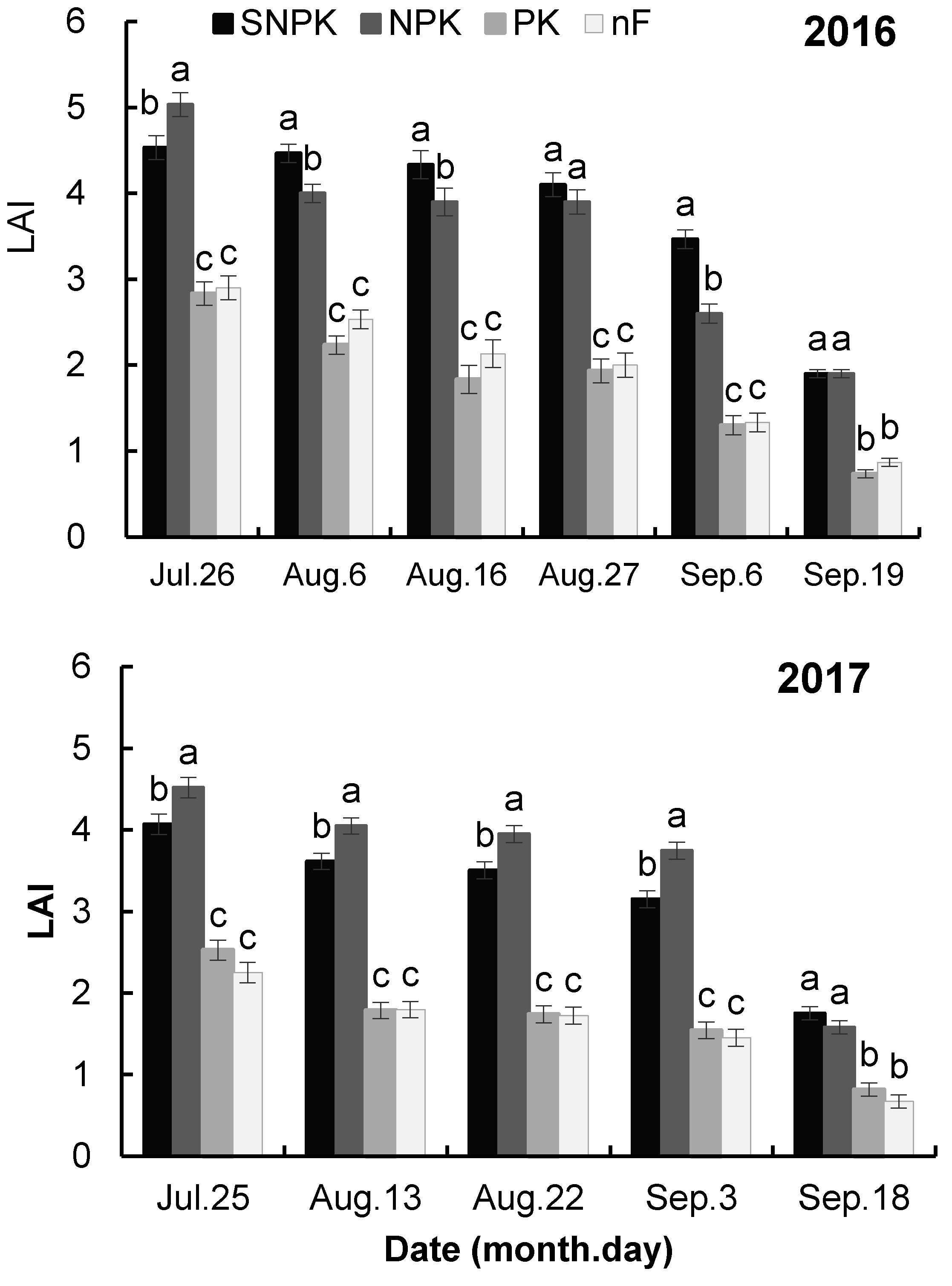
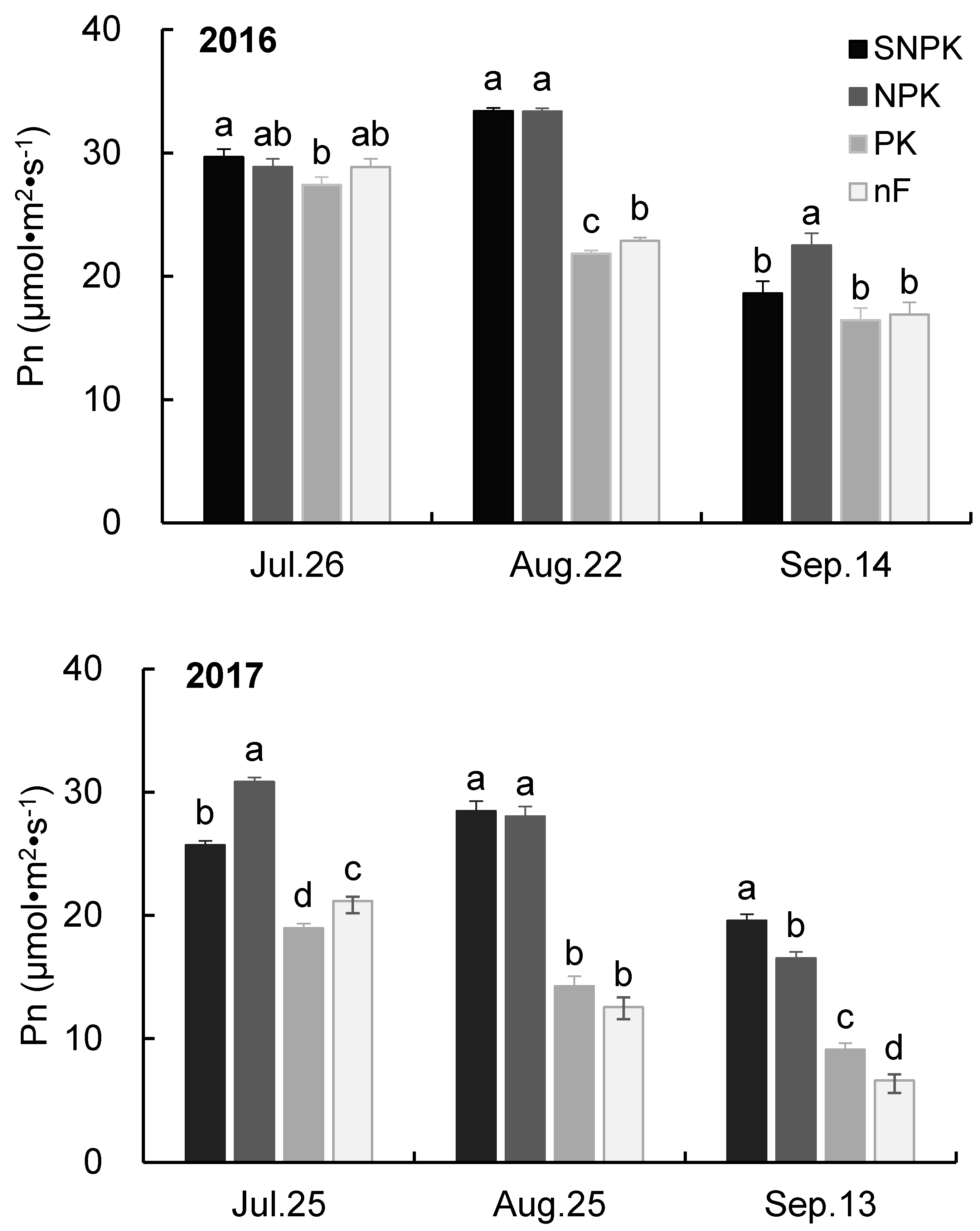

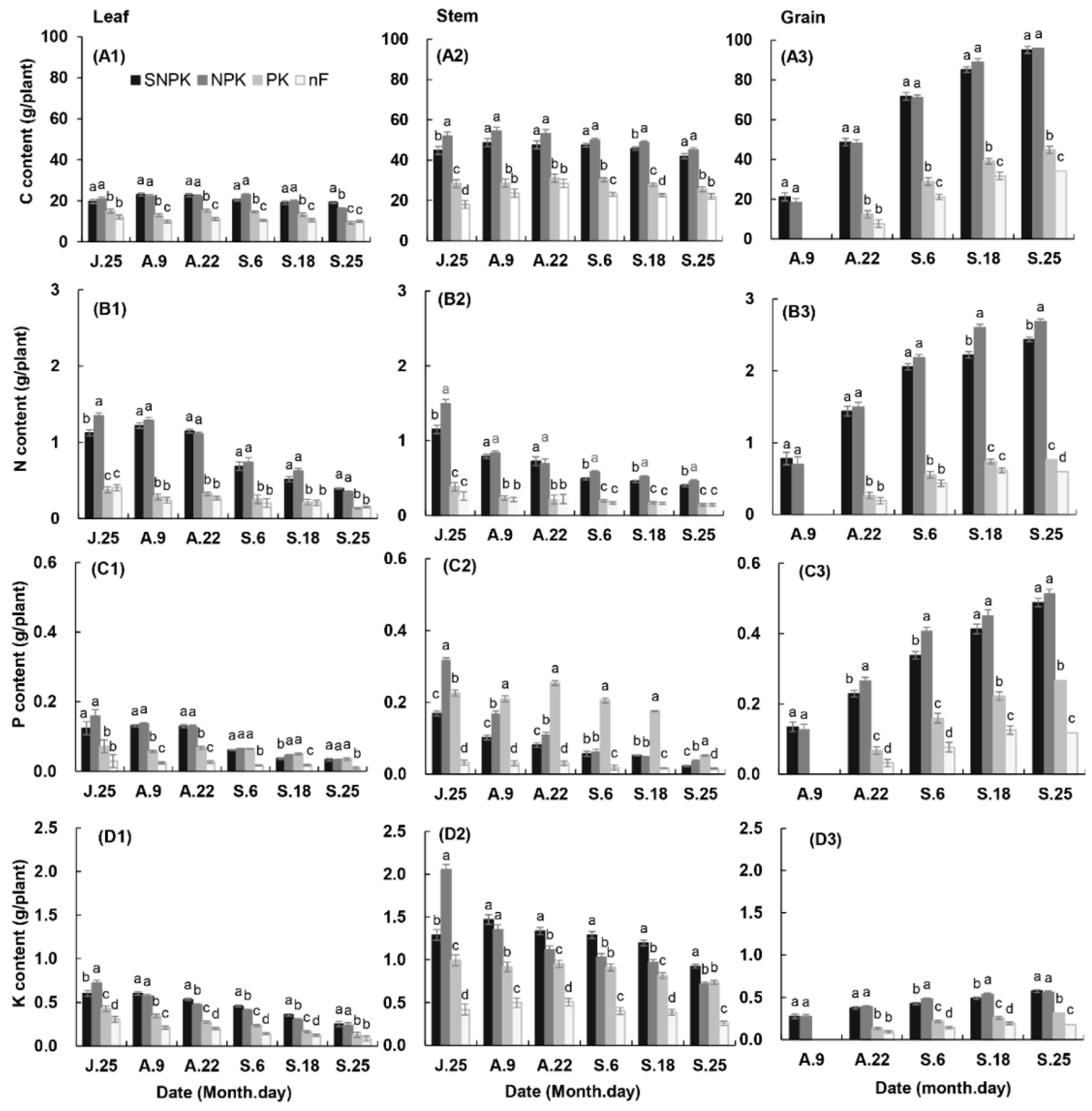
| Treatments | SOM (g kg−1) | TN (g kg−1) | TP (g kg−1) | TK (g kg−1) | AN (mg kg−1) | AP (mg kg−1) | AK (mg kg−1) |
|---|---|---|---|---|---|---|---|
| SNPK | 33.72 | 1.59 | 0.87 | 20.58 | 120.31 | 58.42 | 184.67 |
| NPK | 28.73 | 1.50 | 0.83 | 20.13 | 127.5 | 99.92 | 166.05 |
| PK | 29.04 | 1.40 | 0.93 | 20.46 | 103.83 | 119.04 | 213.32 |
| nF | 28.81 | 1.35 | 0.53 | 20.33 | 99.10 | 5.46 | 148.16 |
| Treatments | Straw NPK # | N Fertilizer | P Fertilizer (P2O5) | P Fertilizer (K2O) | ||||
|---|---|---|---|---|---|---|---|---|
| Amount (kg ha−1) | Time | Amount (kg ha−1) | Time | Amount (kg ha−1) | Time | Amount (kg ha−1) | Time | |
| SNPK | Straw 7571 N 53 P2O5 12.1 K2O 56.8 | before seeding | 112 | 1/3 at sowing and 2/3 at V6 | 82.5 | Sowing | 82.5 | Sowing |
| NPK | 0 | 165 | 1/3 at sowing and 2/3 at V6 | 82.5 | Sowing | 82.5 | Sowing | |
| PK | 0 | 0 | 82.5 | Sowing | 82.5 | Sowing | ||
| nF | 0 | 0 | 0 | 0 | ||||
| Item | Yield (kg ha−1) | Kernel Ear−1 | TKW (g) | HI |
|---|---|---|---|---|
| 2016 SNPK | 11464.3 (224.7) a | 570.7 (9.7) a | 384.3 (8.1) a | 0.52 (0.001) a |
| NPK | 11789.1 (224.7) a | 576.7 (9.7) a | 400.2 (8.1) a | 0.51 (0.001) a |
| PK | 4486.0 (224.7) b | 292.0 (9.7) b | 313.8 (8.1) b | 0.44 (0.001) b |
| nF | 4100.9 (224.7) b | 228.7 (9.7) b | 302.7 (8.1) b | 0.46 (0.001) b |
| Mean | 7960.1 (136.9) | 417.0 (6.0) | 350.3 (4.8) | 0.48 (0.007) |
| 2017 SNPK | 13505.9 (315.1) a | 581.3 (13.7) a | 431.2 (10.9) a | 0.56 (0.002) ab |
| NPK | 13719.3 (315.1) a | 596.7 (13.7) a | 381.0 (10.9) a | 0.57 (0.002) a |
| PK | 5041.3 (315.1) b | 306.0 (13.7) b | 292.4 (10.9) b | 0.51 (0.002) b |
| nF | 3615.3 (315.1) b | 244.7 (13.7) b | 304.9 (10.9) b | 0.47 (0.002) b |
| Mean | 8970.4 (136.9) | 432.2 (6.0) | 352.4 (4.8) | 0.53 (0.007) |
| Overall mean | 8465.3 (96.8) | 424.6 (4.2) | 351.3 (3.4) | 50.5 (0.5) |
| Year | *** | ns | ns | *** |
| Treatment | *** | *** | *** | *** |
| Year × Treatment | ** | ns | ** | ns |
| Leaf | |||||||||||||
| Cf | C | C△ | Nf | N | N△ | C/N | Pf | P | P△ | Kf | K | K△ | |
| Grain yield | * | * | * | * | * | * | |||||||
| Kernel No. | * | * | * | * | ** | ||||||||
| TKW | * | * | * | ** | * | * | * | ||||||
| Stem | |||||||||||||
| Cf | C | C△ | Nf | N | N△ | C/N | Pf | P | P△ | Kf | K | K△ | |
| Grain yield | * | ** | * | * | |||||||||
| Kernel No. | * | * | * | * | |||||||||
| TKW | * | * | ** | * | |||||||||
| Leaf | |||||||||||||
| Cf | C | C△ | Nf | N | N△ | C/N | Pf | P | P△ | Kf | K | K△ | |
| Grain yield | * | * | * | ** | * | * | * | * | |||||
| Kernel No. | * | ** | * | ** | * | * | * | * | * | ** | |||
| TKW | * | * | ** | ** | * | * | * | * | * | * | * | ||
| Stem | |||||||||||||
| Cf | C | C△ | Nf | N | N△ | C/N | Pf | P | P△ | Kf | K | K△ | |
| Grain yield | * | * | * | ** | * | * | |||||||
| Kernel No. | * | ** | * | * | * | * | |||||||
| TKW | * | ** | ** | ** | ** | * | |||||||
© 2019 by the authors. Licensee MDPI, Basel, Switzerland. This article is an open access article distributed under the terms and conditions of the Creative Commons Attribution (CC BY) license (http://creativecommons.org/licenses/by/4.0/).
Share and Cite
Lv, Y.; Wang, Y.; Wang, L.; Zhu, P. Straw Return with Reduced Nitrogen Fertilizer Maintained Maize High Yield in Northeast China. Agronomy 2019, 9, 229. https://doi.org/10.3390/agronomy9050229
Lv Y, Wang Y, Wang L, Zhu P. Straw Return with Reduced Nitrogen Fertilizer Maintained Maize High Yield in Northeast China. Agronomy. 2019; 9(5):229. https://doi.org/10.3390/agronomy9050229
Chicago/Turabian StyleLv, Yanjie, Yongjun Wang, Lichun Wang, and Ping Zhu. 2019. "Straw Return with Reduced Nitrogen Fertilizer Maintained Maize High Yield in Northeast China" Agronomy 9, no. 5: 229. https://doi.org/10.3390/agronomy9050229
APA StyleLv, Y., Wang, Y., Wang, L., & Zhu, P. (2019). Straw Return with Reduced Nitrogen Fertilizer Maintained Maize High Yield in Northeast China. Agronomy, 9(5), 229. https://doi.org/10.3390/agronomy9050229




